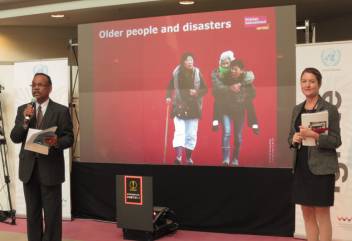 A delegation from HelpAge International, the Network on Ageing in the USA and Annie Lambo and Rosalina Sangales from Ormoc in the Philippines, launched the first Disaster and Age Risk Index.
A delegation from HelpAge International, the Network on Ageing in the USA and Annie Lambo and Rosalina Sangales from Ormoc in the Philippines, launched the first Disaster and Age Risk Index.
The report was unveiled by Annie who untied the ribbon of the first copy at the World Conference on Disaster Risk Reduction in Sendai.
Hundreds of copies of the Index were distributed along with Charter 14, a guide for governments on how to include older people in their disaster risk reduction (DRR) policies and programmes.
Implications of global ageing
Rosalina shared her experience of Typhoon Haiyan, which hit the Philippines in 2013, with the conference delegates. She explained how, with her family and neighbours, they have slowly rebuilt their lives.
Annie highlighted the importance of including older people in DRR plans and urged delegates to make programmes age-inclusive with key roles for older people.
Clodagh Byrne – HelpAge’s Disaster Risk Reduction Policy Adviser – and I explained the implications of global ageing and why it is important for governments and civil society organisations to seriously consider older people, not just as a vulnerable group but as a group valuable for their knowledge, experience and wisdom in building resilient communities.
Governments sign up to Charter 14
The HelpAge team was successful in getting Charter 14 signed by five countries at the conference. A further 20 countries have been given the charter and will consider signing it after consulting their respective governments.
We also had a very productive meeting with the Minister of Social Welfare from Myanmar who asked HelpAge for support to strengthen their DRR policies and programmes. They also encouraged us to sign a Memorandum of Understanding with the department of Relief and Resettlement.
To mark the end of the conference on 18 March, a new DRR framework is being released. We hope the new framework will not only have strong language on including older people but also on the role they can play in DRR work. However, the finalised framework has been delayed.
The final framework
Our concern in the run up to Sendai was that the language in the draft which reflected older people as a at risk group may be watered down. Therefore, we called for older people’s inclusion in all stages of the DRR process including assessments, implementation and monitoring.
However, there is now great concern among the NGO groups that the results of the regional consultations which highlighted the gaps of the previous framework, in terms of prioritising implementation of plans at the grassroots level, have not been recognised within the drafting process.
We hope that when a new framework is agreed it is not weakened to the extent to which it will not reach older people and other marginalised groups who have most to lose and so much to contribute to community resilience.
The main work for HelpAge will be to follow up on the national commitments made by countries and to continue to engage with others to get their political commitment and ensure that older people are no longer excluded from DRR programmes and policies.
More on older people and disaster risk reduction
>> Use our interactive Disaster Risk and Age Index map and download the infographic.
>> Download the Disaster Risk and Age Index (and methodology) report (1.9mb).
>> Read our Disaster Risk and Age Index Storify.
>> Read more about our work on disaster risk reduction and climate change.
>> Find out about Charter 14 for older people in disaster risk reduction.
